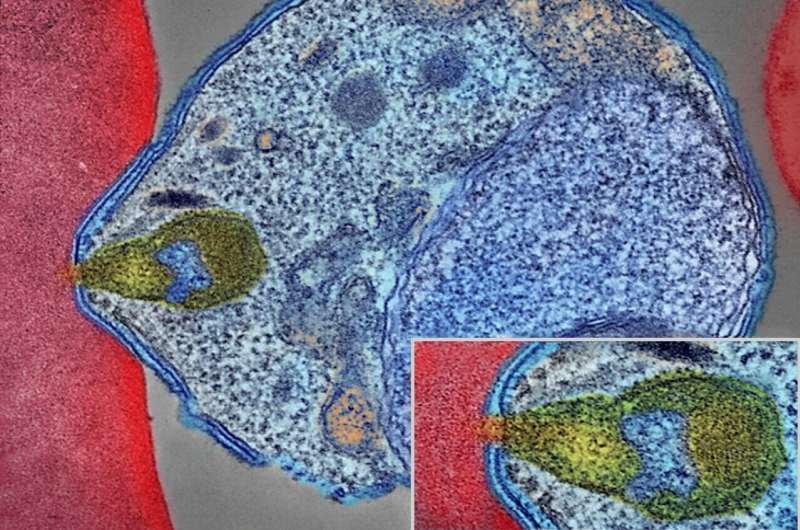
Detecting malaria in people who aren’t experiencing symptoms is vital to public health efforts to better control this tropical disease in places where the mosquito-borne parasite is common. Asymptomatic people harboring the parasite can still transmit the disease or become ill later, after initially testing negative.
The dynamic lifecycle of this pathogen means that parasite densities can suddenly drop below the level of detection—especially when older, less sensitive tests are used. Such fluctuations can make it difficult, when testing only at a single point in time, to determine if an apparently healthy person is in fact infected.
Malaria can produce severe chills alternating with sweaty fevers, headaches, nausea and other distress. Yet many infected people can feel fine.
A recent asymptomatic detection study was conducted in the Katawki District, Uganda, which has a high incidence of malaria.
“We found that parasite dynamics and the parasite species present were highly variable among patients with low-level, asymptomatic infections,” said UW Medicine malaria research Dr. Sean C. Murphy, one of the senior scientists on the study. He noted that sampling every other day or every third day was enough to detect a proportion of infections similar to daily sampling. However, testing once a week or less often, even with sophisticated diagnostics, could misclassify the true infection status of up to one-third of the individuals.
This finding is important, Murphy said, for improving studies on the prevalence of malaria infection and, by extension, for clinical trials of malaria vaccines and therapeutics. Most of these trials use single-timepoint tests or repeated but infrequent tests to determine the infection status of asymptomatic participants. That approach is likely to miss infections if the participants’ parasite densities drop below the limit of the test employed.
Murphy is a physician-scientist and professor of laboratory medicine and pathology and microbiology at the University of Washington School of Medicine and chief of pathology and laboratory medicine at Seattle Children’s.
The project was a collaboration among the Murphy lab; Dr. Thomas Egwang and his research team including Tonny Owalla of Med Biotech Laboratories in Kampala, Uganda; and Dr. Jennifer E. Balkus, professor of epidemiology at the UW School of Public Health. Dr. Dianna E. B. Hergott—who was at the time a graduate student mentored by Murphy and Balkus—and Med Biotech’s Owalla led the study.
The Uganda-based team performed the community-based portions of the study. The participants were healthy, nonpregnant adults, ages 18 to 59, who were not taking antimalarial drugs, as well as older children, ages 8 to 17.
“We instructed participants in how to collect one dried blood spot at home every day for up to 29 days,” Owalla explained. The participants would come to the study clinic once a week to turn in that week’s blood spots, obtain new blood spot cards, and have traditional blood draws.
Diagnostic tests checked the dried blood spots for the presence, classification and densities of Plasmodium ribosomal RNA, which helps produce parasite proteins. The testing strategy also employed “pooling” of the dried blood spots. This approach allowed the team to test more samples cost-effectively, much like the strategies employed at the height of the COVID-19 pandemic.
By analyzing the resulting data, the researchers hoped to discern a sampling schedule comparable to testing every day to reliably identify asymptomatic cases, but less burdensome. On the other hand, the study team wanted to avoid a schedule that was too infrequent and that would end up missing infections.
The scientists categorized the infection trajectory of each participant: no infection whatsoever, newly detected infection, cleared infection, chronic infection, or not able to determine. Looking at the daily results, they also calculated how many infections would still have been detected if the sampling frequency were reduced.
About 60% of all the participants had a Plasmodium infection discovered at some point during the monthlong study. Fewer than half had an infection detected at the study’s outset. The lowest daily report during the study period showed a prevalence of 30%.
The findings are reported in The Lancet Microbe.
Earlier, several other studies had questioned the accuracy of a single measurement to identify infection status. Undetected asymptomatic infections could inadvertently influence research results.
“Serial testing,” the paper authors suggested, “should be considered when trying to determine the true infection status of an individual.”
One of the limitations of their own study, the authors said, was that participants were not asked to collect their dried blood samples at the same time each day. Parasite densities, they noted, could change by as much as 100-fold during a six-hour span.
Owalla is now a graduate student in pathobiology at the UW School of Public Health. He plans to apply his training to further develop advanced solutions for malaria in Africa, the continent most severely affected by this disease.
More information:
Assessing the daily natural history of Plasmodium infection in adults and older children in Katakwi Uganda: a longitudinal cohort study, The Lancet Microbe (2024).
Citation:
Classifying the natural history of asymptomatic malaria (2024, January 4)
retrieved 5 January 2024
from https://medicalxpress.com/news/2024-01-natural-history-asymptomatic-malaria.html
This document is subject to copyright. Apart from any fair dealing for the purpose of private study or research, no
part may be reproduced without the written permission. The content is provided for information purposes only.


